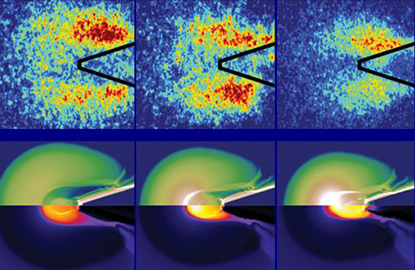
Top: Experimentally measured emission attributable to fast electrons. Bottom: Corresponding contour plots of fuel mass density and electron temperature. Credit: High Energy Density Physics Group, UC San Diego
For laser-powered inertial confinement fusion (ICF) to succeed, scientists need to understand the details of energy transport within the compressed fuel target. A new technique involving X-ray imaging and copper tracers could help probe the secrets of these ultra-high temperatures and pressures (Nature Phys., doi:10.1038/nphys3614).
The researchers, based at the University of California San Diego and General Atomics (USA), studied a particular ICF scheme called fast ignition. First proposed more than 20 years ago, fast ignition separates the compression phase of the target implosion from the heating phase, thus avoiding a central hot spot in the fuel. Measuring only the neutron yield from ICF experiments does not tell scientists about the energy transport within the target.
For their experiments, the team used a target consisting of a hollow gold cone pointing into a two-layer plastic shell, with its interior doped with copper. The target was tiny, with a total radius of 435 μm and a total shell thickness of 38 μm. The 10-ps high-intensity infrared beam from the OMEGA-EP system at the University of Rochester (USA) was directed through the cone into the center of the target. The copper dopant emitted K-alpha radiation that could be picked up by an X-ray spectrometer and spherical Bragg crystal imager.
Modeling the results with computer simulations showed that, in the most efficient configuration, the laser delivered energy to the fuel with up to 7 percent efficiency. That may not sound like much, but it is almost four times higher than previous fast-ignition experiments. Scaling up the results could boost the delivery efficiency as high as 15 percent, but that has not been done experimentally.
The team suggested additional ways to improve the core energy coupling, such as increasing the core areal density or applying magnetic fields to the target.
Scientists from Japan, France, and three other U.S. laboratories also participated in the study.
